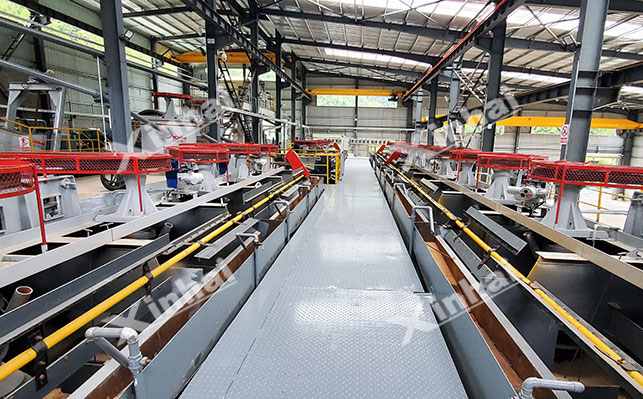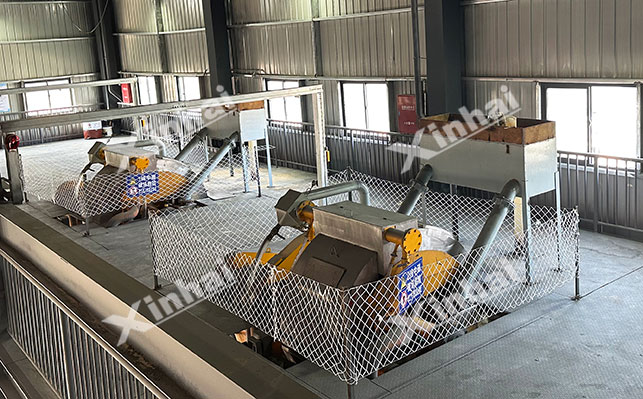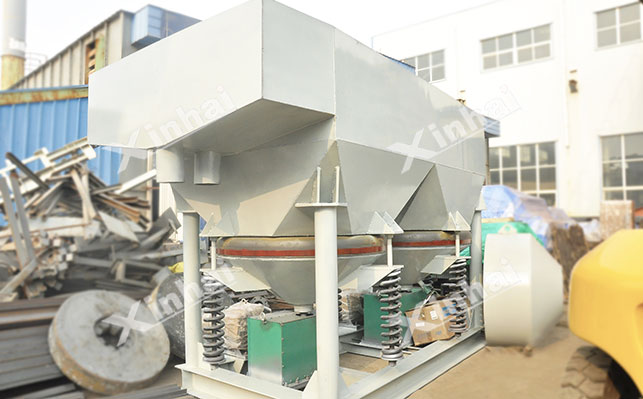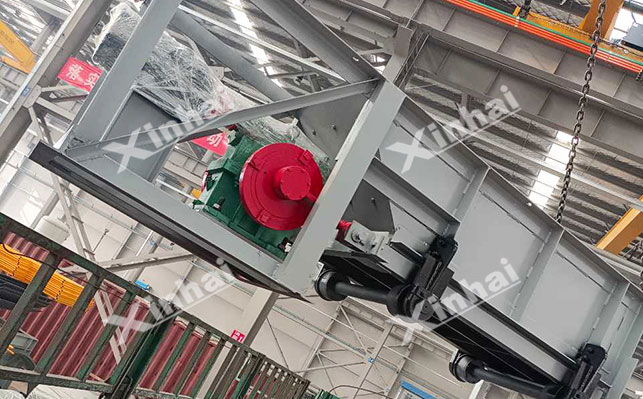
15311826613
Click to add WeChatAs an important rock-forming mineral, feldspar is widely used in glass, ceramics, chemical industry and other fields. However, the mineralization conditions and mineral composition of feldspar ore are different. There are pegmatite feldspar ore, magmatic rock feldspar ore, etc. The beneficiation methods of each type of feldspar are also different. This article will explain the pegmatite feldspar beneficiation methods and equipment.
The main purpose of flotation separation of pegmatite feldspar ore is to separate feldspar from impurities such as quartz and mica. By using the difference in the physical and chemical properties of the mineral surface, by adding flotation agents, the surface of the target mineral (feldspar or impurities) is made hydrophobic, attached to the bubbles and floated to the surface of the slurry, thereby separating it from other minerals.

Under acidic conditions of pH=2-3, the separation of feldspar and quartz can be achieved by flotation using amine collectors. At a specific pH value, amine collectors (such as dodecylamine) can selectively adsorb on the surface of quartz, making its surface hydrophobic and floating with bubbles, while feldspar remains in the pulp.
The flotation process usually adopts a closed-circuit process of "one roughing, three fines and two sweeping". The roughing stage is mainly to make the target mineral (quartz) initially enriched; the fine stage further improves the grade of the concentrate and removes impurities such as feldspar; the sweeping stage is to recover the remaining quartz as much as possible to improve the recovery rate. During the fine process, an adjusting agent such as aluminum sulfate can be appropriately added to enhance the adsorption of the collector and quartz, and an inhibitor such as water glass can be added to inhibit the floating of feldspar.
Mechanical stirring flotation machine: The impeller rotates at high speed to form a stirring effect in the flotation machine tank, so that the pulp and air are fully mixed, and at the same time, it can accelerate the collision and adhesion of mineral particles and bubbles to achieve the flotation separation of minerals. The flotation machine has a large aeration volume and is easy to adjust, which can meet the flotation needs of pegmatite feldspar ores of different properties. It has a wide adaptability to pulp concentration and particle size, and has a large processing capacity.
Aerated flotation machine: Through an external air supply device, the aerator is pressed into the flotation tank to form bubbles. During the flow of the pulp in the flotation tank, the mineral particles contact, collide and adhere to the bubbles, thereby realizing flotation. The slurry flow in the flotation tank of the flotation machine is stable, which is conducive to the adhesion of minerals and bubbles, and can effectively improve the grade and recovery rate of feldspar concentrate.
Flotation column: The slurry is fed from the top of the flotation column and flows downward under the action of gravity. Compressed air enters from the bottom of the flotation column through the air distributor, forming bubbles that move upward. The mineral particles and bubbles collide and adhere during the reverse movement, realizing the flotation separation of minerals. The bubbles attached to the minerals float to the foam layer and are scraped out by the scraper to become concentrate, and the unfloated pulp is discharged from the bottom to become tailings. The flotation equipment has a high flotation enrichment ratio and can effectively improve the grade of feldspar concentrate.
Magnetic separation is based on the difference in magnetic properties between feldspar and impurity minerals. In nature, some impurity minerals such as magnetite, hematite, ilmenite, etc. have strong magnetism, while feldspar itself is usually weakly magnetic or non-magnetic. When the slurry containing these minerals passes through the magnetic field, the magnetic minerals will be affected by the magnetic field force and gather in the area with high magnetic field intensity, thereby separating from feldspar and other non-magnetic minerals. Generally, magnetic separation technology is often used as a pretreatment method in feldspar beneficiation to remove magnetic impurities in the raw ore and create favorable conditions for subsequent flotation and other processes.

Strong magnetic separator: It can generate a higher magnetic field strength, generally up to 0.6-2.0T, suitable for separating mineral impurities with weak magnetism. Its working principle is to generate a strong magnetic field through an electromagnetic coil or a permanent magnet, so that the magnetic minerals are forced to move in the magnetic field to achieve separation from feldspar.
High gradient magnetic separator: It is to set a high gradient magnetic medium in the strong magnetic field area, which greatly enhances the capture ability of weakly magnetic and fine-grained magnetic minerals. Under the conditions of strong magnetic field and high gradient magnetic field, the magnetic force on magnetic particles is greater than the gravity, fluid resistance, etc., so that they are adsorbed on the magnetic medium and separated from non-magnetic feldspar minerals.
Gravity separation is a mineral separation method based on the difference in density between feldspar and impurity minerals. In a gravity field or centrifugal field, mineral particles with different densities will show different movement trajectories and sedimentation velocities. It is generally suitable for processing coarse-grained feldspar ores, and the density difference between impurities and feldspar in the ore is large. In actual production, gravity separation is often used as part of the combined mineral separation process, in conjunction with magnetic separation, flotation and other methods.

Jig: By periodically changing the speed and direction of the water flow, the mineral particles are layered according to density in the jig chamber. In feldspar beneficiation, for coarse-grained feldspar ores (generally greater than 0.5mm), the jig can initially separate impurity minerals with higher density, such as barite. The advantages of the jig are large processing capacity and simple operation, but the sorting effect of fine-grained minerals is poor.
Shaking table: suitable for processing fine-grained feldspar ores (generally 0.03-2mm). It uses the combined effect of mechanical shaking and water flushing to sort the ore particles on the bed according to density and particle size. The sorting accuracy of the shaking table is high, and it can effectively separate minerals with similar densities such as feldspar and quartz, but the processing capacity is relatively small. In feldspar beneficiation, the shaking table is often used for concentrating operations to further improve the grade of feldspar concentrate.
Chute: It is sorted according to the difference in the settling speed of the ore particles in the inclined chute. It is suitable for processing coarse-grained ores and large processing volumes. In feldspar beneficiation, the chute can be used to pre-discard some of the tailings with higher density to improve the selected grade of subsequent beneficiation operations.
Acid leaching is mainly used to dissolve the iron film on the surface of feldspar and some iron-containing impurities that are difficult to remove by magnetic separation and flotation. Oxalic acid and hydrofluoric acid are commonly used acid leaching reagents. Oxalic acid (H₂C₂O₄) can form a stable complex with iron ions, thereby dissolving iron from the surface of feldspar. In addition to dissolving iron impurities, hydrofluoric acid (HF) can also react with some siliceous impurities, and has a good treatment effect on feldspar ores containing more siliceous inclusions.
During acid leaching, its concentration, temperature and time are key process parameters. Taking oxalic acid leaching as an example, a 3-5% oxalic acid solution is usually used to react at a temperature of 50-60°C for 2-3 hours. If the temperature is too low, the reaction speed is slow, and if it is too high, it may cause oxalic acid to decompose and affect the leaching effect. Stirring is required during the leaching process to ensure that the acid solution is in full contact with the ore, and the stirring speed is generally controlled at 300-400rpm.

The ore after acid leaching needs to be neutralized, washed and other post-treatment steps. Neutralization generally uses lime or calcium carbonate to adjust the pH value of the slurry to 6-7, so that the metal ions in the solution form precipitation. Then, the residual acid and precipitation are removed by filtering and washing to obtain a relatively pure feldspar product. The washed product can be dried to make its water content meet the requirements of subsequent processing.
Reactor: As the core equipment of the acid leaching reaction, it provides a reaction place for feldspar ore and acid, can withstand a certain pressure and temperature, and ensure that the acid leaching reaction is carried out under specific conditions. It is usually made of corrosion-resistant materials, such as enamel, polytetrafluoroethylene lining or stainless steel, to resist the corrosion of acid. The reactor must also be equipped with a stirring device to fully mix the slurry and acid, accelerate the reaction speed, and ensure that the reaction is carried out evenly; at the same time, it has a heating and cooling system to accurately control the temperature according to the reaction needs.
Acid storage tank: used to store acid used in the acid leaching process, such as oxalic acid, hydrofluoric acid, etc. It must have good corrosion resistance and select suitable materials according to the type of acid stored, such as polyvinyl chloride (PVC), fiberglass, etc.
Feeding equipment: The pre-treated pegmatite feldspar ore is evenly and quantitatively fed into the reactor to ensure the continuous and stable acid leaching reaction. Common feeding equipment includes vibrating feeders, screw feeders, etc.
Filtration equipment: After the acid leaching reaction is completed, it is used to separate the acid leaching liquid and solid residue to obtain a preliminarily purified feldspar product. Generally, vacuum filters, plate and frame filter presses and other equipment are used.
Washing equipment: Wash the filtered feldspar product to remove the acid and impurities remaining on the surface and improve the product quality. Usually a water washing tank or continuous washing equipment is used to reduce the acid ion and impurity content in the product through multiple water washings.
Wastewater treatment equipment: Wastewater containing pollutants such as acid and heavy metal ions will be generated during the acid leaching process. It is necessary to remove harmful substances such as acid and heavy metal ions in the wastewater through processes such as neutralization, precipitation, and ion exchange. The equipment mainly includes neutralization tanks, sedimentation tanks, ion exchange resin columns, etc.
Ventilation equipment: Harmful gases may be generated during the acid leaching process, such as hydrogen fluoride gas generated by the volatilization of hydrofluoric acid. Corrosion-resistant fans and pipes are required to collect the harmful gases and discharge them into the atmosphere after treatment through purification devices.
The above is an introduction to the beneficiation methods and commonly used equipment for pegmatite-type feldspar ores. In actual beneficiation plants, the selection of processes and equipment must be based on the properties of the feldspar ore. It is recommended to conduct beneficiation tests and design suitable feldspar process plans and a complete set of feldspar beneficiation equipment based on test analysis to improve the recovery rate of feldspar.